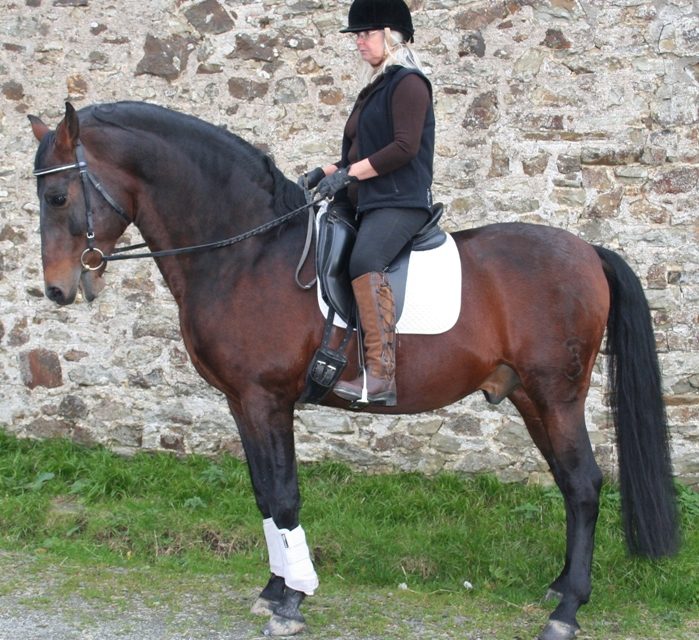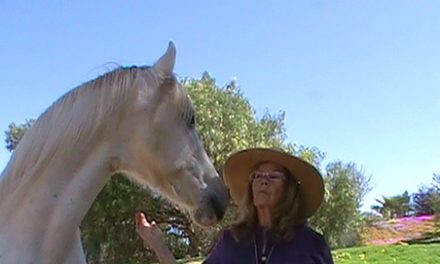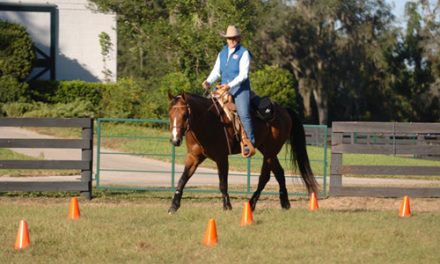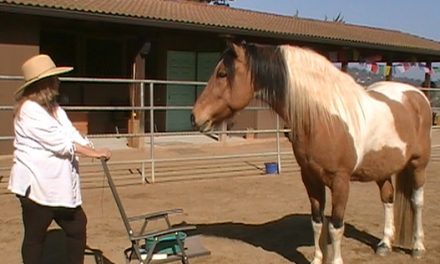It will be beneficial when you first sit in the saddle to take a few moments to check your posture from top to toe as described in my last article. Begin by riding forward with “allowing” reins. Focus on your core breathing and feel the building of power and energy with the inward breath and the release and flow of energy with your outward breath. Take a very deep outward sigh, rippling down your upper torso into your core to release any tension. This will help to relax your body releasing tension through your muscles and joints. Allow the next inward breath just to happen in a natural way. Remember when you give a deep sigh it is just a gentle release of energy through your body. This is a different feel to the outward breath which directs the stronger energy from the core towards the horse, which will instigate his movement.
BREATHE INTO WALK
When you feel calm and focused top to toe, take up an allowing contact with the reins then inhale, followed by a more vigorous outward breath. The exhalation will ripple down your spine, releasing through your core, which will encourage the horse to move forwards. This movement for the rider is similar to sitting on a swing and pushing it forwards and upwards but it is much more subtle.
If your horse does not respond, use your legs once and if needed back up with a tap of the whip on your own leg. Very quickly the horse will tune into this sequence of aids and respond from your breath alone. Remember the high sensitivity of your horse and tune into his mind to build your connection.
When the horse is walking forwards, continue breathing naturally and rhythmically with every few strides. Imagine you are jogging and supporting your running with steady inhalation and exhalation.
BREATHE INTO THE HALT
When you ask the horse to halt, your deeper inward breath will lengthen and strengthen your spine, creating stability and acting as a half halt. As the horse responds, increase the inward breath, close your fingers on the reins and ask him to halt. Once the horse is standing still, release the pressure of your fingers on the reins so he can stand immobile in a good self carriage. Gain his focus with your steady core breathing. He should be calm and still, yet ready to move on your next deeper, energizing exhalation. If the horse is allowed to stand with only a light contact with the reins, his forward movement can be in lightness and not bearing down.
TRANSITIONS FROM WALK to TROT
Prepare by walking forwards with a good energy and rhythm. Before you trot forwards make sure the horse is relaxed into a steady contact with the reins. This will not be created by pulling back with your hands but from the energy from the hind limbs. This active motion from behind will increase movement through all his joints and will mobilize his spine. This flow of energy will create a release through his back. His head and neck will arch and lengthen naturally as a result of a calm, attentive mind and good, positive energy.
Spend a few minutes trying to gain this feeling. Breathe steadily in a natural rhythm, becoming more aware of expanding your core on the inward breath and releasing gently through your core on exhalation.
Encourage the horse to come and “sit under you,” bringing his hind legs through to develop better self carriage. In this way, his forehand and shoulders will feel lighter. Just picture a see-saw with two people, both weighing the same, sitting at either end. Now picture a heavier person who makes the see saw tip down with the extra weight. Whilst one end will lower, the other end will elevate. This is similar to the horse when he uses more energy to propel and elevate; his forehand will lighten and he will feel more freedom in his shoulders.
When you prepare to trot, first make sure you have a marching, energetic rhythm in walk. Then take a deeper inward breathe to rebalance and further engage the movement, gaining his attention for a change in gait. Then allow a stronger breath outwards and feel the energy ripple down through your spine, which will release and mobilise your seat. If the horse does not respond then use your legs, just once, and re-enforce with a tap of the whip, if needed.
Focus on your regular natural breathing and use the deeper outward breath to instigate more energy. Tap once with your legs if the horse is not attentive to your energising breath. The horse will soon tune into your breathing alone which will enable your legs just to hang in a relaxed way down either side of the horse’s rib cage. In this way your natural balance will not be continually disrupted.
If your horse tries to pull and get too strong in your hands, rebalance with more focus on more deep inhalation and if necessary, close your fingers on the reins.
Your more intense inward breath will expand and strengthen your seat and core. This will give stability to the horse who will feel this momentary resistance to his forward movement. He will then rebalance and with a more allowing contact from your hand and fingers, you can encourage him to move forward with more lightness.
When you take the deeper inward breath, it not only lengthens and strengthens your spine but you will feel the tightness through your upper leg and thigh. The horse is extremely sensitive to any change of balance or restriction from the rider. The feeling of restraint which is just a momentary check from the rider, will probably be sufficient to steady the horse.
The horse will quickly learn to listen to core breathing as your first aid when asking for any change, whether in pace or direction. Techniques of breathing can energise a lazy horse or equally calm an anxious horse. Breathing awareness will enhance communication between horse and rider. This will open up a path towards harmony and lightness.
HOMEWORK:
Spend a few moments before riding to focus on your posture and breathing. Then once in the saddle explore these techniques. Become “core aware” and try to make your seat and core the first aid before any change in pace. Start to feel you are flowing with the motion of the horse and how you can influence him from just your core breathing. Enjoy your journey!
My next article will explore these techniques further.
Jenny gives clinics with her Iberian stallions. Her book and DVD ‘Ride From the Heart’ are available from her web site www.spanishdressagehorses.com.
Jenny Rolfe is a Classical trainer who has developed unique communication skills of self awareness, breathing and body language to connect with the horse. She gives clinics with her four Iberian stallions to demonstrate these methods. Every rider is looking for harmony and Jenny can help riders at all levels aspire to a deeper connection – in their own self awareness and with their horse. Many of Jenny’s clients are trainers – several have BHSI qualifications seeking a natural approach to training. Several have Pirelli qualifications but seek further education. Jenny seeks to connect the relationship from the ground with her knowledge of Classical horsemanship. Jenny has written an inspirational and highly acclaimed book entitled “Ride From the Heart” published by J A Allen. The book follows a progressive path of horsemanship using techniques of breathing and body language to communicate with the horse. Jenny has explored the Classical principles through her training with chief instructors of the Portuguese School of Equestrian Art in Lisbon. She also writes internationally and within the UK for “British Dressage” and “Classical Riding Club.” The first DVD in a series now has been produced, based upon the teaching within her book, and is availabe through her website and from RideMagazine.com DVD Store. For further information please visit her web site www.spanishdressagehorses.com.







